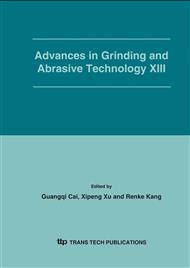p.545
p.550
p.555
p.560
p.565
p.570
p.575
p.579
p.584
Numerical Simulation of Magnetic Field Distribution in MAF
Abstract:
Magnetic field distribution (MFD) plays an important role in magnetic abrasive finishing (MAF). The mathematical models of the MFD in MAF have been established, and forced behavior of magnetic abrasive (MA) in the magnetic field has been analyzed in this paper. The MFD characteristics of the grooved poles have been numerically simulated, and the distribution law of magnetic force, interaction force and interface pressure have been investigated based on a single particle. The calculated results show that the MFD in the finishing zone is directly affected by the pole structure and working gap. The mapping function of interaction force and interface pressure corresponds to corner-effect in the peak point of the pole, and the magnetic brush stiffness is changed by the diameter and magnetization characteristics of MA, and the magnetic flux intensity (MFI). The numerical simulations are in a good agreement with the experiments. All of results mentioned above will offer an important method to study further on the finishing mechanism.
Info:
Periodical:
Pages:
565-569
Citation:
Online since:
February 2006
Authors:
Price:
Сopyright:
© 2006 Trans Tech Publications Ltd. All Rights Reserved
Share:
Citation:


